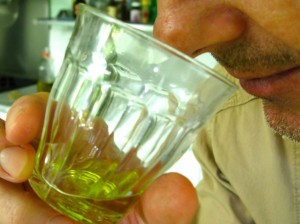Anyone can learn to taste well. You can replicate at home the same procedure that professional olive oil tasters follow to judge olive oil. Here’s the test suggested by “Olio&Olive”*
START THE TEST
To start your tasting experience, you will need a small plastic cup, a bottle of olive oil and a glass of water. You will have a better result if you don’t drink coffee or smoke at least 30 minutes before the time set for your test and if you don’t use any perfume, cosmetic or soap whose scent could linger during the test. It’s recommended to use at least three or four different olive oils made with different species of olives to discover an array of flavors and intensities.
Pour just a small quantity of olive oil in the cup (enough to cover the bottom), hold the cup top and bottom between your hands to warm it slightly and swirl it for at least one minute.Remove your hand and smell the oil. Keep in mind that extra virgin olive oil should smell and taste of the fruit from which it is made…it should be fruity and smell of olives, fresh cut grass, aromatic herbs or fresh fruit – all of which are considered positive attributes.
Good Characteristics
Fruity
Let’s not forget that olives are fruit so a good olive oil needs to have some degree of fruitiness. This can come from ripe olives or unripe (green) olives. Olive oil should taste fresh, not heavy and “oily”.
Bitter
Yes, bitter is good. Bitterness is a characteristic of fresh olive oil. Olives are bitter. The degree of bitterness depends on how ripe the olive is. So a bitter olive oil is a positive thing. However, depending on your taste you may want to find an olive oil that has a balance of fruity and bitter that you can tolerate.
Pungent
This is a peppery characteristic that you will feel at the back of your throat when you swallow the oil. You may even cough. Many people think this is bad (like my friend) but it is not, it is actually of olive oil from unripe olives and of fresh olive oil. It also signifies the presence of certain antioxidants. And remember this peppery sensation should go away fairly quickly, it should not linger.
Read more: http://www.olivetomato.com/how-to-recognize-good-and-bad-olive-oil/#ixzz3UCaww4sA
If these aromas are not present, it is possible that the olive oil is flat, poor quality or has gone bad. These undesirable aromas can be described as rancid, old, metallic, musty,humid or fusty. If you recognize one of these undesirable odors, you should not proceed with the tasting as your palate will be affected by these flavors (and you will need that glass of water!).If the aroma is good and you recognize the positive attributes, take a tiny sip and let it work in your mouth. Swirl it around and suck in air to oxygenate the oil. Taste it some more and then swallow. Take notes on your sensations and impressions.Remember that every extra virgin olive oil will affect your taste buds differently and each flavor sensation will come about quicker or slower, so…let it get to work!Do you like the taste? Is it light or heavy? Does it increase in intensity of flavor as you hold it on your tongue? Is it pungent, peppery, bitter? Is it grassy, fruity, oily?
*Olio&Olive is an importer and online gourmet store for the finest Italian olive oils, plus a tightly scrutinized and edited assortment of excellent olives, balsamic vinegars, pastas, …http://www.olioandolive.com |

